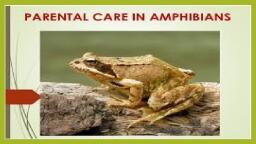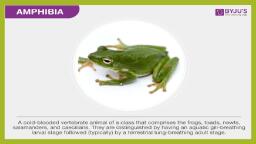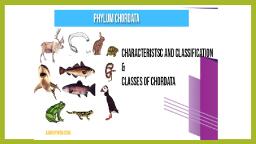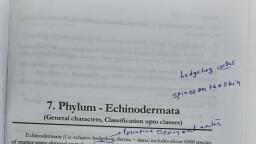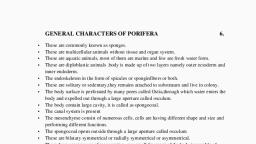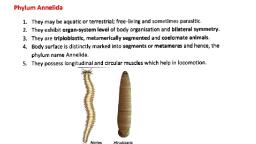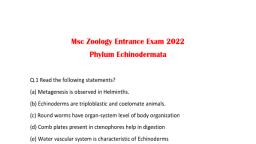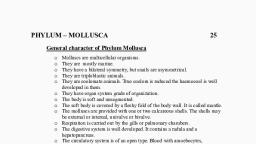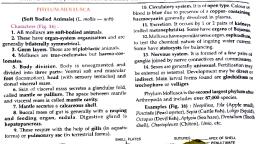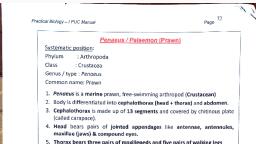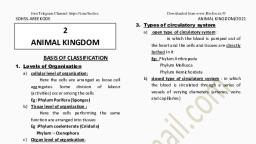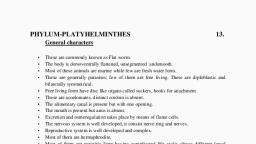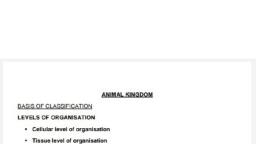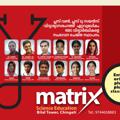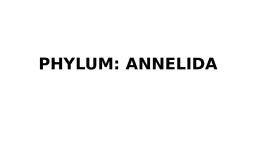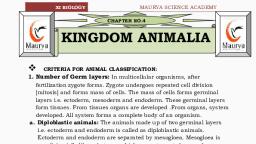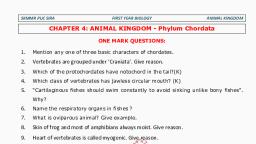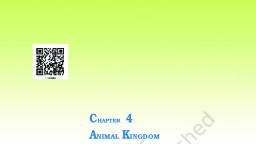Page 2 :
General Characteristics of Phylum Echinodermata:, Habitat: All existing echinoderms are marine. They generally live at sea bottom while a few are pelagic (free swimming on surface in open water) and a few are sessile (attached to the substratum)., Organization: organ system , Symmetry: The symmetry is bilateral in larvae but pentamerous radial in adults i.e. body parts are arranged in fives or multiples of five., Germ layers: triploblastic, Body Cavity: There is a true enterocoelic coelom., Body Form: It varies considerably. The body is star-shaped, heart-shaped elongated or cylindrical, globular, circular or with feathery arms. It is un-segmented. The body lacks head., Body Wall: Epidermis is single layered and ciliated. In many echinoderms there is endoskeleton of calcareous plates in the dermis which are mesodermal in origin.
Page 3 :
Circulatory system: They have an open type blood circulatory system with five radiating vessels. In this case, the heart is absent and blood does not contain any respiratory pigment. This system is also known as haemal and perihaemal system., Respiratory system: Different types of respiratory organs are found in different echinoderms such as dermal branchiae or papulae in starfish, genital bursae in the brittle star, peristominal gills in sea urchin and cloacal respiration in Holothurians., Digestive system: They have complete digestive tract but in some species such as a brittle star, it is incomplete., Sense Organs: They are poorly developed (tactile organs, terminal receptors, chemoreceptors, photo-receptors etc).
Page 4 :
Sexes and Fertilization: Except a few individuals, the sexes are separate. There is no sexual dimorphism. Fertilization is usually external., Asexual Reproduction: Some forms reproduce asexually by self-division., Autotomy and Regeneration: Phenomena of autotomy and regeneration are often well marked in echinoderms. , Development: The development is indirect and includes a ciliated, bilaterally symmetrical larva that undergoes metamorphosis to change into the radially symmetrical adult. Different larval forms are found.
Page 10 :
(1) Madriporite :- The madreporite is a rounded calcareous plate occurring on the aboral surface of the central disc in inter-radial position. Its surface bears a number of radiating, narrow, straight or wavy grooves or furrows. Each furrow contains many minute pores at its bottom. Each pore leads into a very short, fine, tubular pore-canal. Which passes inward in the substance of the madreporite. There may be about 200 pores and pore-canal. The pore-canals unite to form the collecting canals. Which open into an ampulla beneath the madreporite.
Page 12 :
(2) Stone Canal :- The ampulla opens into a "S" shaped stone canal. The stone canal extends downwards (orally) and opens into a ring canal, around the mouth. The walls of stone canal are supported by a series of calcareous ringd. The lumen of stone canal is lined by very tall flagellated cells. in embryonic stages and young Asterias, the stone canal remains a simple tube but in adult Asterias, lumen of stone canal possesses a prominent ridge with two spirally rolled lamellae. , (3) Ring Canal :- The Ring canal or water ring is located to the inner side of the peristomial ring of ossicles and directly above (aboral) to the hyponeural ring sinus. It is wide and pentagonal or five sided. , (4) Tiedmann's Bodies :- The ring canal gives out inter radially nine small, yellowish, irregular or rounded glandular bodies called racemose or Tiedmann's bodies from its inner margins. The Tiedmann's body rest upon the peristomial ring of ossicles. The actual function of tiedmann's bodies is still unknown, however they are supposed to be lymphatic glands to manufacture the amoebocytes of the water vascular system.
Page 13 :
(5) Pollian Vesicles :- The ring canal gives off on its outer side in the inter radial position one, two or four little, pear shaped, thin walled contractile bladder or reservoirs with long necks called pollian vesicles. They are supposed to regulate pressure inside ambulacral system and to manufacture amoeboid cells of ambulacral system. , (6) Radial Canal :- From its outer surface the ring canal gives off a radial water canal into each arm that runs throughout the length of the arm and terminates as the lumen of terminal tentacle. In the arm the radial water canal runs immediately to the oral side of the ambulacral muscles. , (7) Lateral Canal :- In each arm, the radial canal gives out two series of short, narrow, transverse branches called lateral or podial canals. Each lateral canal is attached to the base of a tube foot and its provided with a valve to prevent backward flow of fluid into the radial canal. , (8) Tube feet :- As already mentioned, there are four rows of tube feet in each ambulacral groove. A tube foot is a hollow. elastic, thin walled, closed cylinder or sac-like structure having an upper sac like ampulla, a middle tubular podium & a lower disc like sucker. The ampulla lies within the arm, projecting into the coelom above the ambulacral pore which is a gap between the adjacent ambulacral ossicles for the passage of the podium. The tube feet are chief locomotory and respiratory organ of Asterias.
Page 14 :
Function of Water Vascular System :- , The water vascular system has three main functions. They are as follows- , (1) Locomotion :- , The water vascular system is used mainly for locomotion. The inner wall of the water vascular canals are provided with cilia. The beating of the cilia causes the seawater to enter through the madreporite. Finally, the seawater reaches the tube feet and their ampullae. , The ampullae contract ; the valves at the junction of the lateral canals and tube feet, prevent the flow of water into radial canals. , The water is forced into the podia. The podia are elongated and protected out through the ambulacral groove. Then the suckers are applied to the substratum. , The tube feet now contract & push the body forward. The water from the tube feet is pushed into the ampulla. Hence, the tube feet shorten. The suckers are released. Then the ampulla contracts & the whole process is repeated. , (2) Food Capture :- , The tube feet are used to capture the prey. The suckers are used to open the shells of molluscas. , (3) Attachment :- , The Starfish can be attached to the rocks by the tube feet.

